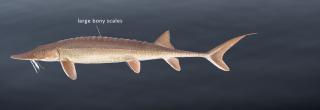
Shovelnose Sturgeon
NOTE: While regulated as a game species, law now requires that all sturgeon must be released immediately to protect the larger pallid, which looks a lot like the shovelnose at a young age.
Sturgeon Family: Sturgeon are primitive fish with a cartilaginous skeleton, shovel-like snout, four barbels under the snout in front of a toothless mouth, long shark-like tail, and bony plates or scutes on the body. They have small eyes, and use a highly developed sense of taste to locate food in turbid water. Their streamlined body shape makes them well-suited for swift-moving waters, and they are found in the Missouri, Yellowstone and Red rivers.
Shovelnose Sturgeon Identification
- Long shark-like tail
- Bony plates or scutes on the body
- Short shovel-like snout
- Toothless mouth
- Barbels located in front of the mouth with the two center barbels almost as long as the outside barbels
Notes
The Shovelnose sturgeon, which seldom exceeds 5 pounds, is our most abundant sturgeon.
Sturgeon are slow-growing, late-maturing fish with a long life span, which makes them sensitive to overharvest.
Law now requires that all sturgeon must be released immediately to protect the larger pallid, which looks a lot like the shovelnose at a young age.
